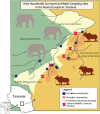A "one health" approach to address emerging zoonoses: the HALI project in Tanzania
- PMID: 20016689
- PMCID: PMC2784942
- DOI: 10.1371/journal.pmed.1000190
A "one health" approach to address emerging zoonoses: the HALI project in Tanzania
Abstract
Jonna Mazet and colleagues describe their work in the Tanzania-based HALI Project, which adopts the “One Health” approach to address emerging zoonoses and that recognizes the interconnectedness of human, animal, and environmental health.
Conflict of interest statement
The authors have declared that no competing interests exist.
Figures



References
-
- World Health Organization. Data and statistics: Causes of death. Geneva: World Health Organization; 2009. Available: http://www.who.int/research/en/. Accessed 24 April 2009.
-
- World Health Organization. The control of neglected zoonotic diseases: A route to poverty alleviation. 2006. Report of a joint WHO/DFID-AHP meeting, 20 and 21 September 2005, WHO Headquarters, Geneva, with the participation of FAO and OIE. Available: http://whqlibdoc.who.int/publications/2006/9789241594301_eng.pdf. Accessed 28 July 2009.
-
- Jones KE, Patel NG, Levy MA, Storeygard A, Balk D, et al. Global trends in emerging infectious diseases. Nature. 2008;451:990–993. doi: 10.1038/nature06536. - DOI - PMC - PubMed
-
- Moran M, Guzman J, Ropars A-L, McDonald A, Jameson N, et al. Neglected disease research and development: How much are we really spending? PLoS Med. 2009;6:e1000030. doi: 10.1371/journal.pmed.1000030. - DOI - PMC - PubMed
Publication types
MeSH terms
LinkOut - more resources
Full Text Sources
Medical

